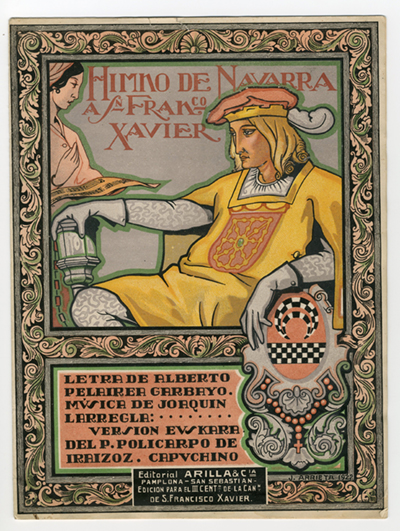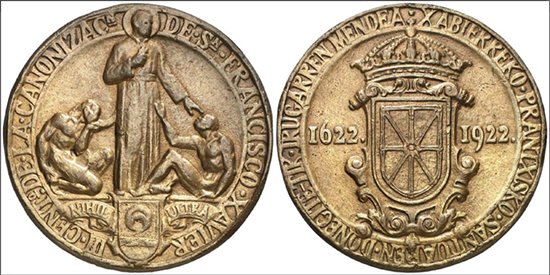Julio Arrieta at the service of the image of the III Centenary of the canonization of St. Francis Xavier in Navarre

PhotoPrivate collection/Designationof the medal - obverse and reverse - of the pilgrim of the III Centenary of the canonization, made with the design of Julio Arrieta, in 1922.
In the same way that a hymn for the centennial festivities was awarded to the musician Joaquín Larregla and the poet Alberto Pelairea, the visual image of those anniversaries had an illustrator and cartoonist who made position, at least four designs for the official program of events, the cover of the hymn, the pilgrim's medal and the commemorative medal.
The author of all this was Julio Arrieta, whom the sources refer to that year as a "distinguished artist from Pamplona", although in July 1922, when Diario de Navarra reviewed the confectioners of the Pamplona City Hall and its submission, it was stated that they were very beautiful and in very good taste, subject to the design presented by "the accredited industrialist Mr. Julio Arrieta". On the occasion of the royal visit of Alfonso XIII to the castle and the celebration, the press reported that the celebratory decoration was under the control and direction of Julio Arrieta, "of whose artistic taste there is no doubt, it was at the height of always: order and beauty presided over the arrangement of the altar and the dais". We know that his qualifications led him to be on the commission that was to decide on the 1924 San Fermín poster, together with Javier Ciga and Fermín Istúriz.

Left: Cover designed by Julio Arrieta for the official program of the III Centenary of the canonization of St. Francis Xavier in Navarra, published in Pamplona in 1922. Right: Coat of arms of Navarre and Javier designed by Julio Arrieta for the back cover of the official program of the III Centenary of the canonization of St. Francis Xavier in Navarre, published in Pamplona in 1922.
The program of events, beautifully illustrated by Artes Gráficas de Pamplona in 1922, has a two-color cover by Arrieta, the drawing itself in sepia on a yellow background. In it we find a great altarpiece with the bank with angels and a registration in which we read "EDITION FOR THE III CENTENARY OF THE CANONIZATION OF S. FRANCISCO XAVIER", a single body in whose interior it shows a circular medallion with a drawing of the castle and the date 1922, on it, and an attic with a cross between curved moldings, fruits and the registration CASTILLO DE XAVIER. The back cover shows a shield stamped by the royal crown with the arms of Navarre and in what would be the fourth quarter those of Javier.
The Official Hymn, the work of Joaquín Larregla and Alberto Pelairea was luxuriously edited in a score by the Arilla House of Pamplona San Sebastian, for which they counted on the prestigious engraving and printing workshop of A. Boileau and Bernasconi of Barcelona, founded in 1913 by Alessi Boileau Bernasconi, born in Verona in 1875 and trained as an engraver at the publishing house Ricordi of Milan, before moving to the Catalan capital in 1904.
The color cover of this composition is, without a doubt, one of the richest of the musical works related to Navarre and Javier. The protagonism corresponds to one of the mace-bearers of the Diputación, seated with the ceremonial mace of the Kingdom and the coat of arms of Javier with a rosary. In the upper left margin a matron with the score is ready to interpret and in the lower part is placed the degree scroll, the authors with their names and that of the Capuchin Father Policarpo de Iraizoz, author of the version of the lyrics in Basque.

Cover of the score of the Hymn to Javier de Larregla y Pelairea, published by Casa Arilla with the illustration designed by Julio Arrieta and engraved by the prestigious house A. Boileau of Barcelona in 1922.
The pilgrim's medal is almond-shaped and was reported in the magazine La Avalancha ( March 8 and 24, 1922), with the drawing in pen on the front and back and the following text: "The pilgrims' medal: The board organizer of the Centenary adopted among its first agreements, that of minting a medal for the pilgrims who, in this Jubilee year, go to the Castle of Javier, wedge of the Apostle of the Indies, and commissioned the project drawings for the same to the distinguished Pamplona artist Mr. Julio Arrieta. Here are reproduced the drawings according to which the medals are already being minted, with these original representations of the Saint and his native Castle. The board wanted the medal of the pilgrim to Javier to be something not vulgar, and this desire has been perfectly interpreted and fulfilled, as the readers can see, both in the form of the medal and in the way of treating its decorative elements. Mr. Arrieta himself has also designed the official commemorative medal for the Centennial, whose drawings will be published in another issue of LA AVALANCHA". The minting was done according to the designs and their inscriptions, stating the commemorative dates and the reason for the minting -pilgrimage to the castle-.

design of the pilgrim's medal made by Julio Arrieta in 1922, published by La Avalancha Magazine in March 1922. Photo Binadi
The commemorative medal referred to in the text we have just transcribed is a rarer piece. It is referred to in a small paragraph of another issue of La Avalancha ( April 24, 1922), where the artist who made the medal, Ramón Arcaya (1895-1943), is mentioned. It measures 55 mm. in diameter. The information reads: "Our fellow countryman Ramón Arcaya has finished the model, according to the model of Don Julio Arrieta for the official medal of the Centennial. This drawing has on the obverse side the image of San Francisco with a converted and a miraculously cured person, on the reverse side the arms of Navarra. The registration of the medal will be in romance on the obverse and in Basque on the reverse. This medal has all the character of the medals of the time of the Canonization". As for Ramón Arcaya, it should be noted that he was trained at the School of Arts and Crafts in Pamplona, Madrid and Paris. Thanks to a scholarship granted by the Diputación Foral de Navarra he was able to fill in his training in Spain, France and Italy, entering in contact with the work of the great masters, singularly Donatello or Michelangelo, with which he received the stamp of the Italian Renaissance, looking for in his work the classic realism and the expressiveness of the human figure, as we appreciate in the two characters that appear next to the saint in the obverse of the medal that occupies us.

Commemorative medal of the III Centenary of the canonization of Javier. Designed by Julio Arrieta and made by Ramón Arcaya. Private collection
LEARN MORE
Diario de Navarra, July 5, 1922
The AvalancheMarch 8 and 24, 1922
LaAvalancha, April 24, 1922
MURUZÁBAL DEL SOLAR, J. M., "El escultor Ramón Arcaya", Revista Pregón Siglo XXI, no. 21 (2003)
URRICELQUI PACHO, I., La pintura y el ambiente artístico en Navarra (1873-1940), Pamplona, Government of Navarra, 2009.
